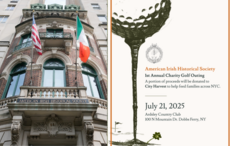Findmypast is working in partnership with IrishCentral to share fascinating insights into your Irish ancestors. Click here to get a special half price subscription, and discover your Irish roots today!
As we delve deeper into our family history research, we begin to imagine how our ancestors lived out their daily lives. The clothes they wore, the food they ate and the towns and streets they lived in become as important to their story as who their grandfathers and daughters were. Records found on Findmypast, including Thom’s Directory and Dublin newspapers give researchers an unparalleled insight into the capital city and its inhabitants in the 1800s.
Upper Baggot Street is a long street of impressive nineteenth century houses whose residents today are a similar mix to those that were there 150 years ago - solicitors and boutique businesses - with one notable exception.
In 1872, a dairy yard was causing complaints, excessive manure was building up behind the houses. The proximity of the dairy yard to a busy city street was not unusual in the days before refrigeration, as fresh milk in the 19th century meant getting it from the cow to the table in as short a time as possible, especially in the heat of the summer months.
On Barrow Street in 1884, a new gasometer had been installed. Gas lighting had been introduced into the city as early as 1825, taking over from oil, and continued up until 1957 for some street lighting, despite the introduction of electric lighting some fifty years before. It was along these flickering lit streets that your Dublin ancestors walked on autumn evenings.
Coming to the attention of the newspapers for many usually meant an initial encounter with the law. On Chancery Lane in the old medieval quarter of the city, we find cases of theft, fines for selling porter without a license and assault, including that of Patrick Bergin against his wife. He is, intriguingly, the one-legged dancing champion of the world. It does not say whether he is a one-legged dancer, or whether he simply dances on one leg.
On Henrietta Street, we find an intriguing mix of notices and advertisements over the lifetime of this once opulent street which throughout the nineteenth century went from respectable address to teeming tenements. There are notices of men being called to bar (Oriel O’Hanlon, 1892), and an advertisement placed in search of a butler, and then there is poor John Abbot who was injured by a runaway bullock in September 1898. The changing fortunes of the street are reflected in the many auction notices.
Use Findmypast’s collections to discover a truly authentic take on life in 19th Century Dublin and see what you can find out about the Dubliners in your family tree.
For more stories on tracing your Irish heritage from Findmypast click here.




Comments